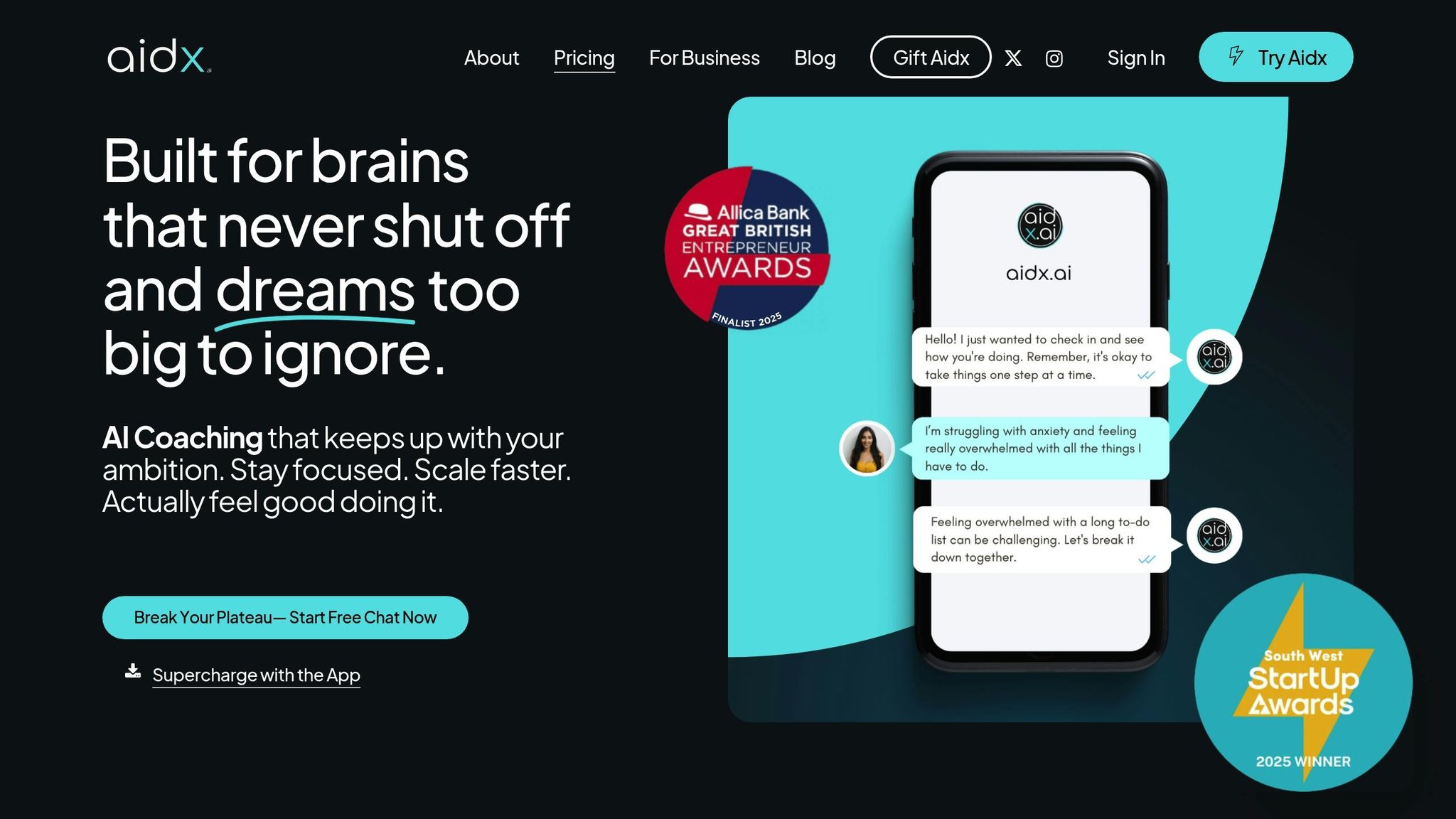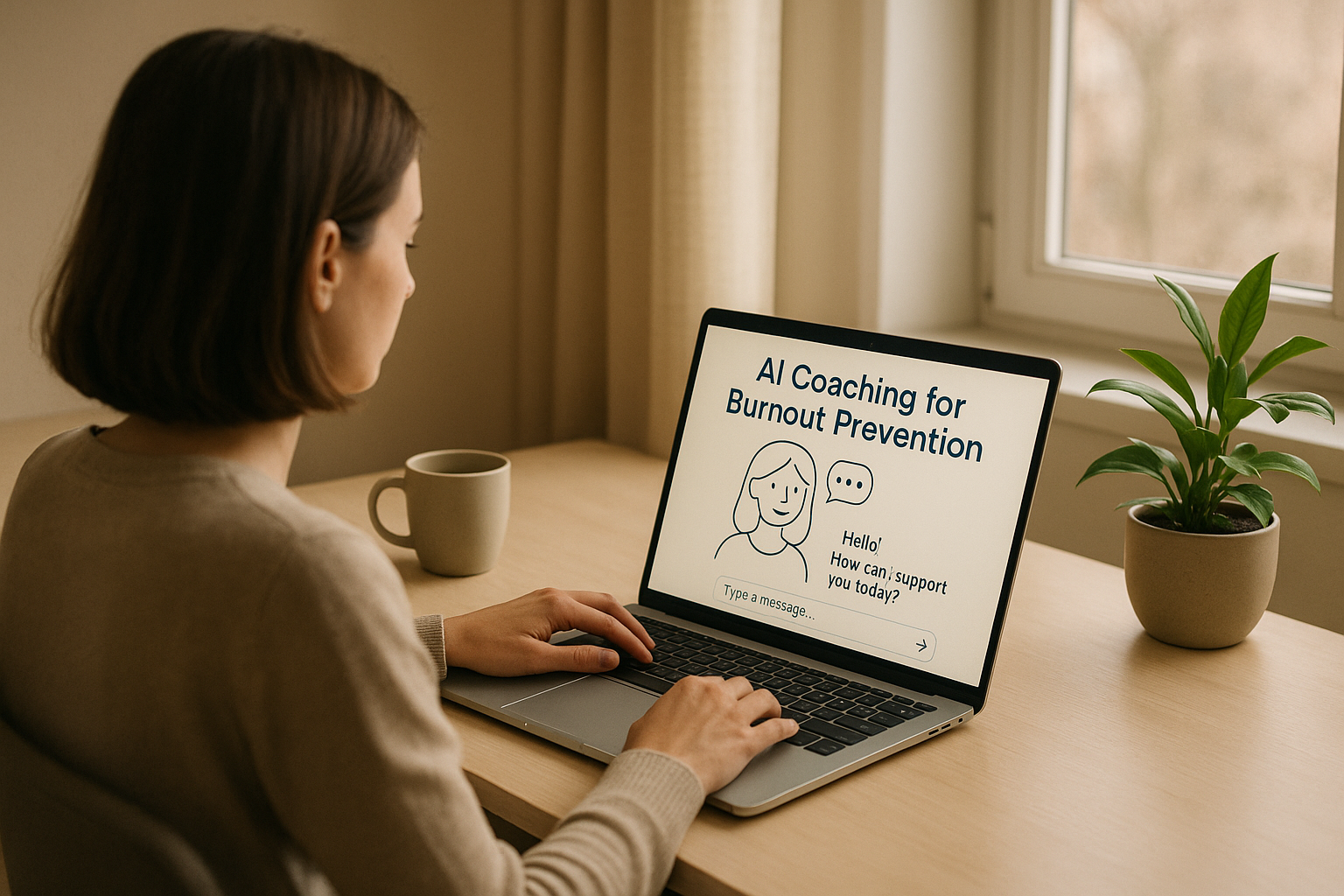Burnout is a growing problem in today’s work culture, but AI coaching tools are offering a new way to tackle it. These tools provide personalized, 24/7 support to help manage stress and prevent burnout before it escalates. Unlike traditional methods that often rely on generic solutions and delayed interventions, AI tools like Aidx.ai use advanced techniques to deliver tailored guidance in real time.
Key Takeaways:
- Burnout Symptoms: Emotional exhaustion, detachment, and reduced personal accomplishment.
- Challenges of Traditional Methods: Delayed help, one-size-fits-all approaches, limited accessibility, and workplace stigma.
- AI Coaching Benefits: Real-time support, personalized strategies, privacy, and flexibility.
- How It Works: Tools like Aidx.ai use behavioral data and therapeutic techniques (CBT, ACT, DBT, NLP) to identify stress triggers and provide actionable guidance.
- Modes of Use: Quick microcoaching, private sessions, and ongoing self-monitoring to integrate stress management into daily routines.
AI coaching bridges the gap between recognizing stress and taking action. By offering instant, tailored support, it enables individuals to build resilience and maintain well-being, even in high-pressure environments.
The Future of Coaching 🤝 AI Mastery with Jaymes O’Pheron | Chipp Builder Series
How AI Coaching Tools Address Burnout
AI coaching tools offer a proactive way to tackle burnout, focusing on identifying stress patterns early and building coping mechanisms before issues escalate. Instead of waiting for stress to boil over, these tools step in to provide timely support and guidance.
Managing Stress and Mood Before Problems Start
Preventing burnout hinges on catching stress before it spirals. AI coaching tools shine in this area by monitoring subtle shifts in communication, mood, and stress levels during everyday interactions.
Take Aidx.ai, for example. Its Adaptive Therapeutic Intelligence (ATI) System™ analyzes your words and tone during conversations, picking up on stress signals even before you’re fully aware of them. This early detection system allows for immediate action. If Aidx notices rising stress levels, it might suggest a quick microcoaching session using techniques like CBT (Cognitive Behavioral Therapy) or ACT (Acceptance and Commitment Therapy) to help you reframe your thoughts or refocus on what matters most.
The system doesn’t stop there. It learns your specific stress triggers – maybe you consistently feel stressed on Sunday nights thinking about the work week ahead or after certain meetings. Once these patterns are identified, Aidx proactively reaches out through its notification system, sending gentle reminders via push notifications, email, or Telegram to check in and offer support before stress levels peak.
Personalized Methods for Building Resilience
Generic advice on managing stress often falls flat because everyone’s challenges and coping styles are different. AI coaching tools address this by tailoring resilience-building strategies to fit your unique needs and circumstances.
Aidx’s ATI System™ draws from a range of proven therapeutic methods, including CBT, Dialectical Behavior Therapy (DBT), ACT, and Neuro-Linguistic Programming (NLP). It doesn’t apply these techniques randomly; instead, it learns which ones resonate with you through ongoing interactions.
For instance, if you tend to catastrophize about work deadlines, Aidx might focus on CBT techniques to help you challenge negative thought patterns. It could guide you through exercises to separate realistic concerns from anxiety-fueled scenarios. Over time, as you practice these skills, the system adjusts its approach based on your progress.
If emotional overwhelm is your main challenge, Aidx could lean on DBT techniques, teaching you ways to manage distress and regulate emotions. The system’s embodiment mode even helps you visualize a calmer, more resilient version of yourself, making abstract concepts feel more real and actionable.
Aidx also turns these insights into practical steps. You can set goals to practice new stress management techniques, with reminders and check-ins to keep you on track. Its self-monitoring tools track your emotional state, confidence, and stress levels over time, giving you clear evidence of your progress.
This personalized approach ensures that support evolves with you, seamlessly integrating into your life.
24/7 Support When You Need It
Stress doesn’t follow a schedule, and that’s where AI coaching tools truly stand out – they’re available anytime you need them. Whether it’s pre-meeting jitters at dawn, processing a tough conversation during lunch, or late-night worries about a presentation, help is always within reach.
This constant availability is particularly useful for high-performing professionals with unpredictable schedules or frequent travel. Traditional therapy can be hard to fit into a busy life, but AI coaching adapts to your routine effortlessly.
Aidx’s voice-enabled interface makes accessing support even easier. You can have a coaching session while walking to work, driving between meetings, or taking a quick office break. There’s no need to set aside dedicated time or find a private space – you just speak naturally and receive instant guidance.
For sensitive situations, the platform offers an incognito mode. These private sessions automatically delete after 30 minutes, making it easier to process delicate emotions or work through confidential challenges without leaving a trace. This is especially helpful for workplace conflicts or other sensitive stressors.
With multi-platform integration, you can access support wherever it’s most convenient – on your desktop, phone app, or even through Telegram for quick updates. Your progress is synced across all platforms, ensuring a seamless experience.
This constant, flexible availability creates a safety net that traditional methods can’t match. Knowing you have immediate access to support helps prevent small stressors from snowballing into bigger issues. It transforms stress management into an ongoing, natural part of your daily routine, fitting seamlessly into your life.
Adding AI Coaching to Your Daily Routine
With around-the-clock support, integrating Aidx.ai into your daily life can be straightforward and effective. The key? Start small. Build simple habits that create a reliable system for managing stress and preventing burnout.
Getting Started with Aidx.ai

Setting up Aidx.ai is quick and easy, and you can customize it to fit your specific needs. Access the platform through the web app, install it on your device as a PWA, or use Telegram for fast, convenient interactions.
During onboarding, you’ll outline your main goals and identify key stressors. This step isn’t just a box to check – the Adaptive Therapeutic Intelligence (ATI) System™ uses this information to personalize its support from the very beginning. For instance, if work stress is a major issue, the system will focus on techniques from CBT and performance coaching that are tailored to professional challenges.
You can also configure notifications – whether via push alerts, email, or Telegram – to catch stress early. Many users find these timely reminders especially helpful during hectic periods, ensuring stress doesn’t spiral out of control.
Your self-monitoring preferences determine how Aidx tracks your progress. The platform can monitor emotional states, stress, anxiety, confidence, and performance metrics, but you decide how often to reflect. Some prefer daily mood logs, while others opt for weekly reviews. It’s all about finding what works for you.
Using Different Modes for Different Needs
Aidx.ai offers several modes designed to meet your specific needs and fit into your schedule. Knowing how and when to use these modes can make a big difference in how effectively you manage stress.
- Microcoaching mode: Need quick relief? These 5-minute sessions are ideal for busy moments, like between meetings, before a presentation, or whenever stress starts to creep in. They provide actionable advice in just a few minutes.
- Embodiment mode: This mode helps you visualize and physically experience a calmer, more confident version of yourself. It’s great for unwinding at the end of the day or breaking free from negative thought cycles. Instead of just discussing challenges, you’ll engage in exercises that help you feel the change.
- Incognito mode: For those moments when privacy is essential, incognito mode offers completely confidential sessions that automatically delete after 30 minutes. Whether it’s a sensitive workplace issue or a personal conflict, this mode encourages openness and deeper reflection.
- Default mode: This is your go-to for regular check-ins and personal development. It uses a mix of therapeutic techniques, including CBT, DBT, ACT, NLP, and coaching strategies, adapting to your emotional state and recent interactions.
Many users create a rhythm with these modes. For example, you might start your day with a quick microcoaching session to set intentions, use incognito mode to process a tough conversation during lunch, and finish with embodiment mode to prepare for tomorrow’s challenges.
Once you’ve chosen the right mode for the moment, the next step is turning insights into real-world actions.
Turning Insights into Action
Aidx.ai doesn’t just help you understand your stress – it helps you do something about it. Its integrated planning system bridges the gap between self-awareness and actionable steps.
For example, if the platform notices you’re consistently stressed about deadlines, it won’t just point it out. Instead, it’ll guide you to break large projects into smaller, manageable tasks and set reminders to track your progress.
The goal-setting feature works seamlessly with notifications and progress tracking, turning vague goals like “reduce stress” into measurable outcomes. Over time, you’ll see concrete improvements through detailed emotional and performance metrics. Maybe you’ll notice lower stress levels after using certain techniques or higher confidence scores when following specific routines.
To keep you on track, Aidx.ai uses multi-channel follow-ups. If you discover a helpful insight during a morning session, the platform might check in later to see how you’re applying it or remind you to practice a new strategy before a stressful event.
sbb-itb-d5e73b4
Getting the Most from AI Coaching
Achieving success with AI coaching goes beyond merely having access to the technology. It’s about building systems that transform insights into meaningful and lasting changes. The most effective users focus on three key practices: consistent self-monitoring, making data-driven adjustments, and knowing when to turn to human support.
Tracking Your Progress and Building Habits
At the heart of effective AI coaching is self-monitoring. Aidx.ai’s tracking system helps you keep tabs on your emotions, stress levels, anxiety, confidence, and overall performance. By tracking these daily, you lay the groundwork for real, actionable change.
Start with quick 30-second daily check-ins, both in the morning and evening. Rate your stress on a scale from 1 to 10, and note any major stressors or wins from the day. This simple habit creates a baseline that the Adaptive Therapeutic Intelligence (ATI) System™ can use to detect patterns and tailor its support to your needs.
To make the most of this system, tie your tracking to SMART goals – specific, measurable, achievable, relevant, and time-bound. For example, during a demanding project, you might aim to complete three 5-minute microcoaching sessions each week to manage stress effectively.
Consistency is key, and multi-channel notifications can help. Whether through push alerts, Telegram, or email, these reminders ensure that insights translate into actions. For instance, if you report high stress after back-to-back meetings, Aidx.ai can suggest scheduling 10-minute breaks between appointments to help you recharge.
Take time for weekly reviews to evaluate your progress. Look at your emotional and performance data to identify what’s working and what needs tweaking. These reviews not only help you refine your strategies but also allow you to spot trends that might otherwise go unnoticed.
This steady tracking and review process helps you build habits and refine your approach to stress management over time.
Using Data to Understand Your Patterns
Daily tracking is just the first step. By diving into the data, you can uncover patterns that reveal what’s driving your stress and how best to address it. For example, analytics might show that your stress spikes after certain types of meetings, during specific project phases, or on Mondays after catching up on weekend emails.
These insights empower you to take proactive steps. If, for instance, you notice that anxiety peaks between 2–4 PM, you could schedule focused work in the morning and block off time for microbreaks or stress-reducing activities in the afternoon. Similarly, if late-night emails are a trigger, you might set boundaries by disabling notifications after a certain hour.
In January 2024, Training Magazine highlighted how organizations are using AI to track stress levels and provide personalized support at scale. The article emphasized the importance of pairing real-time monitoring with targeted interventions and stressed the need for transparency to maintain trust[4].
Use trend lines to see whether your interventions are working. Over a period of 2–4 weeks, track whether your strategies are lowering stress levels or improving consistency. If the data shows no improvement despite consistent efforts, this could indicate it’s time to escalate to human support.
To stay ahead of potential burnout, establish threshold triggers for immediate action. For example, if your stress consistently rates above 7 out of 10 for three days straight, or if you’re getting less than six hours of sleep for several nights, these are clear signals to prioritize recovery or seek additional help.
Working with Human Coaches When Needed
Sometimes, even the best AI-driven strategies reach their limits. That’s when human expertise becomes essential. Aidx.ai’s hybrid model bridges the gap between AI and human support, ensuring you get the help you need when situations become more complex.
If high stress persists for two weeks despite targeted AI interventions, or if you experience challenges like missed deadlines, workplace conflicts, or symptoms of burnout, it’s time to involve a human coach. The Practitioner Mode allows therapists and coaches to stay connected to your progress through Aidx.ai’s data. They can assign tasks, track your emotional patterns, and offer tailored advice based on real-time updates. This approach adds continuity that traditional weekly therapy sessions often lack.
When transitioning to human support, your AI coaching data becomes an invaluable tool. Summarize your stress patterns, successful strategies, and persistent challenges to give your coach or therapist a clear starting point. This preparation can accelerate your progress by focusing on the areas where you need the most help.
By combining AI and human expertise, you get the best of both worlds. AI handles the day-to-day tracking, stress management, and habit-building, while human coaches address deeper emotional challenges or major life transitions. Together, they create a balanced approach to personal growth.
For corporate users, Aidx.ai offers anonymous, aggregated insights that help teams identify stress trends without compromising individual privacy. Managers can spot patterns like meeting overload or deadline clustering, while employees continue to enjoy confidential coaching sessions.
Conclusion: Using AI to Prevent Burnout
Burnout is a growing crisis, with 77% of employees feeling its effects in their current roles and organizations facing 50% higher turnover rates due to overworked staff[3]. Traditional wellness programs often miss the mark, leaving room for a new approach: personalized, on-demand support that meets individuals where they are.
This is where AI steps in. Tools like Aidx.ai provide real-time interventions that go beyond weekly coaching sessions. Whether it’s a guided breathing exercise, a mindfulness prompt, or a quick nudge to pause and reset, AI can help manage stress in the moment, preventing it from escalating into chronic burnout[5].
The Adaptive Therapeutic Intelligence (ATI) System™ takes this a step further by tailoring support to your unique needs. Instead of generic advice, it analyzes your behavioral patterns, emotional states, and stress triggers to offer highly targeted coping strategies. Whether you’re navigating a packed schedule, racing to meet deadlines, or struggling with after-hours emails, the system adjusts to your circumstances for maximum impact[1][5].
AI coaching bridges the gap between understanding stress and taking action. Features like integrated planning tools, multi-channel reminders, and detailed tracking help you build lasting stress management habits. With voice-enabled functionality, you can access support hands-free – during your commute, between meetings, or whenever you need immediate help.
For organizations, the benefits are clear. Companies using AI coaching report higher employee engagement and retention by offering tailored support and personal development opportunities[1]. Tools like Aidx Corporate also provide managers with anonymous, aggregated insights, helping them identify stress patterns – like meeting overload or tight deadlines – without compromising individual privacy. This approach combines daily AI-driven check-ins with human coaching for more complex issues, creating a well-rounded support system.
If you’re ready to take the first step, try a 14-day experiment. Use an AI coach for daily voice check-ins, set reminders to take breaks, schedule two 5-minute microcoaching sessions during your day, and review your stress patterns weekly. For teams, consider piloting AI coaching with a small group and measuring stress levels at 30 and 60 days to assess its impact[1][2][3].
AI coaching offers a practical, personalized way to manage stress and prevent burnout. It’s not just a tool – it’s a lifeline, available whenever you need it most.
FAQs
How does Aidx.ai customize stress management strategies for each user?
Aidx.ai takes a personalized approach to stress management through its Adaptive Therapeutic Intelligence (ATI) System™. By analyzing your emotional state, behavior patterns, and personal goals, it crafts techniques specifically designed to address your unique circumstances and challenges.
The platform also offers real-time support, integrating proven methods like CBT (Cognitive Behavioral Therapy), DBT (Dialectical Behavior Therapy), and ACT (Acceptance and Commitment Therapy). This combination helps you strengthen your resilience and take meaningful steps toward better stress management and improved well-being.
How does Aidx.ai help identify and address stress triggers effectively?
Aidx.ai taps into proven therapeutic methods such as CBT (Cognitive Behavioral Therapy), DBT (Dialectical Behavior Therapy), ACT (Acceptance and Commitment Therapy), NLP (Neuro-Linguistic Programming), and performance coaching to help pinpoint and address stress triggers.
With its Adaptive Therapeutic Intelligence (ATI) System™, Aidx tailors its approach based on your emotional state and past interactions. This real-time personalization equips you with strategies to strengthen resilience and adopt healthier ways to manage stress.
How does Aidx.ai support busy professionals in managing stress and achieving their goals?
Aidx.ai is available 24/7, making it a perfect companion for busy professionals. Whether you’re commuting, taking a quick break, or burning the midnight oil, you can access personalized coaching and emotional support whenever you need it. This round-the-clock availability ensures that it fits effortlessly into even the most hectic schedules.
Thanks to its multi-platform integration, Aidx.ai works seamlessly across a web app, mobile app, and messaging platforms like Telegram. This means you can stay connected on your favorite devices without missing a beat. With such easy access, you can manage stress, maintain focus, and steadily work toward your personal and professional goals – all without interrupting your daily flow.



